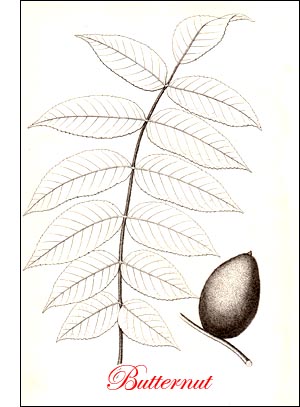Butternut or Oil Nut or White Walnut Tree
 Butternut, Oil Nut, White Walnut (Juglans cinerea, Linn.)A short-trunked, spreading tree, 50 to 75 feet high, with broad, rounded dome. Bark grey, rough, with broad furrows and narrow ridges, showing paler under bark. Shoots covered with clammy down. Wood light brown, light, soft, coarse grained, with satiny lustre. Buds often one above another in axils, hairy, flattened, terminal largest; inner scales later becoming leaf-likeflower buds naked. Leaves alternate, compound, of 11 to 19 leaflets, hairy, taper pointed, serrate, sessile, except terminal leaflet, 15 to 30 inches long, yellow-green, turning yellow in autumn; leaflets 3 to 5 inches long; petioles and veins pubescent and clammy. Flowers, May, with leaves, staminate in catkins, 3 to 5 inches long, yellow-green with copious pollen; pistillate in 6 to 8-flowered racemes, covered with glandular hairs; stigmas 2, bright red, spreading; ovule solitary at base of pistil. Fruit, October, an oblong nut in spongy, clammy, sticky, indehiscent husk, with pungent odour; shell thick, deeply sculptured; nut oily, sweet, edible. Preferred habitat, deep, rich loam of river valleys, or well-drained hillsides. Distribution, New Brunswick to Delaware, and along mountains to Georgia and Alabama; westward through Ontario to Dakota, south to Arkansas. Uses: Planted for shade and for nuts. Wood used for interior finish of houses and for cabinet work. Inner bark and husks yield yellow dye and medicinal substances. Sap sweet, sometimes added to maple sap in making sugar. Nuts pickled when green; locally sold when ripe.
Butternut, Oil Nut, White Walnut (Juglans cinerea, Linn.)A short-trunked, spreading tree, 50 to 75 feet high, with broad, rounded dome. Bark grey, rough, with broad furrows and narrow ridges, showing paler under bark. Shoots covered with clammy down. Wood light brown, light, soft, coarse grained, with satiny lustre. Buds often one above another in axils, hairy, flattened, terminal largest; inner scales later becoming leaf-likeflower buds naked. Leaves alternate, compound, of 11 to 19 leaflets, hairy, taper pointed, serrate, sessile, except terminal leaflet, 15 to 30 inches long, yellow-green, turning yellow in autumn; leaflets 3 to 5 inches long; petioles and veins pubescent and clammy. Flowers, May, with leaves, staminate in catkins, 3 to 5 inches long, yellow-green with copious pollen; pistillate in 6 to 8-flowered racemes, covered with glandular hairs; stigmas 2, bright red, spreading; ovule solitary at base of pistil. Fruit, October, an oblong nut in spongy, clammy, sticky, indehiscent husk, with pungent odour; shell thick, deeply sculptured; nut oily, sweet, edible. Preferred habitat, deep, rich loam of river valleys, or well-drained hillsides. Distribution, New Brunswick to Delaware, and along mountains to Georgia and Alabama; westward through Ontario to Dakota, south to Arkansas. Uses: Planted for shade and for nuts. Wood used for interior finish of houses and for cabinet work. Inner bark and husks yield yellow dye and medicinal substances. Sap sweet, sometimes added to maple sap in making sugar. Nuts pickled when green; locally sold when ripe.The butternut is a short-trunked, low-headed tree, with farreaching arms that make a crown wider than it is high. There is a tendency to develop the under buds on each twig. This gives a horizontal rather than an upward trend to the limbs. The foliage, trunk and wood are lighter in colour than those of the black walnut. It is a cheerful tree, but unfortunately short lived, and it is rare to see a tree of considerable size that is not diseased by fungi and blemished by insects. The wind breaks the long limbs, whereupon enemies enter and take possession. The «- inter buds of the butternut are full of character. The leaf scars are prominent, and two or three buds stand in a vertical row above each one. The first bud, just above the hairy "beetling brow" of the leaf scar, is to produce the leafy shoot next spring. Those higher up at the same joint are bare little green pineapplesthe staminate catkins in an immature state. The grey-green downy twigs are clammy to the touch, and inside is the wonderful chambered pith that distinguishes all the walnuts.
One need only crush a twig or leaf of a walnut tree to have revived the memory of long-forgotten experiences in brown October's woods. 0 the smell of those juicy brown husks as we cracked the green nuts on a convenient stone, and wiped our damp fingers ineffectually on the grass! The stains wore off at length, but the memories are indelible. The Shakers of Lebanon, Massachusetts, got a rich purple dye by adding something to the brown extract of those husks.
The wood of butternut is not so hard nor so strong as black walnut, but for the interior finish of houses it has a distinct advantage. Black walnut is sombre compared with the cheerful browns and fawn colours which this wood shows. The "natural wood finish" brings out these quiet tones and imparts a soft lustre to the grain. I t is a pity that this wood is not more common and more widely employed for this particular purpose. It is made into wooden bowls, and used for veneering bureaus, for carriage panels, and for coffins, posts, rails and fuel.
The frugal housewife in the country looks with interest upon the butternut when it is half grown-when the pale green, clammy, fuzzy fruit hangs in clusters, surrounded by its umbrella of leaves. If a knitting needle goes through husk and nut without hindrance, it is not too late to make "pickled oil nuts," which are a delectable relish with meats in winter. The husk and all are put down in vinegar, sugar and spices. The unpleasant part of this process is the rubbing off of the "fur," after scalding the nuts. This task usually falls to the children.
Butternut husks and bark have long been used in home remedies, and in dyeing woollen cloth. The backwoods regiments in the Civil War were clad in "butternut" jeans. a home-made, home-dyed uniform that worthily stood the hardest service.
Butternut Tree picture